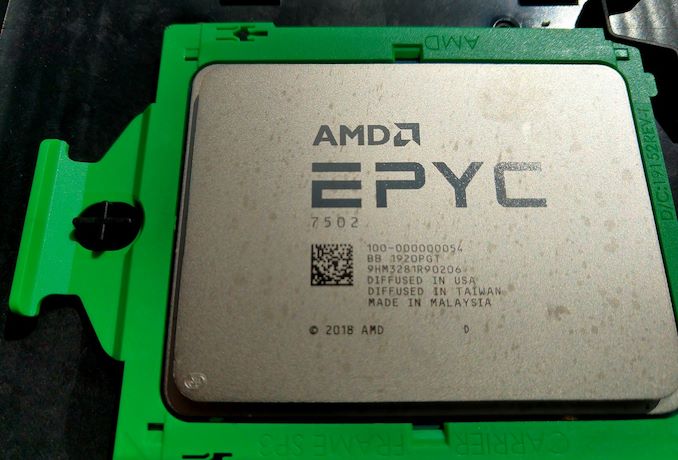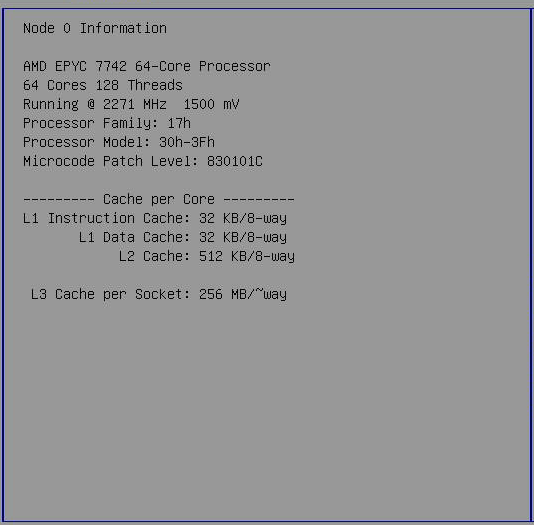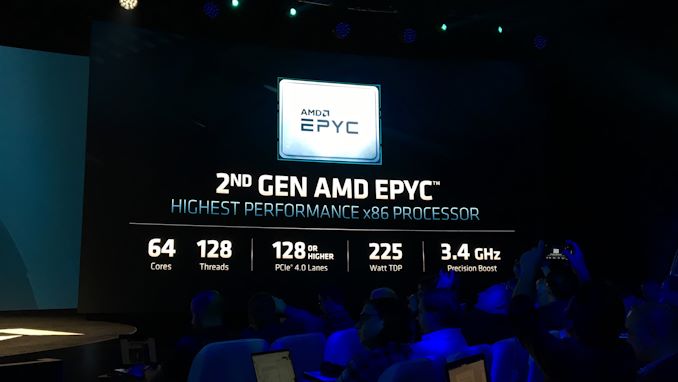AMD Rome Second Generation EPYC Review: 2x 64-core Benchmarked
by Johan De Gelas on August 7, 2019 7:00 PM EST
If you examine the CPU industry and ask where the big money is, you have to look at the server and datacenter market. Ever since the Opteron days, AMD's market share has been rounded to zero percent, and with its first generation of EPYC processors using its new Zen microarchitecture, that number skipped up a small handful of points, but everyone has been waiting with bated breath for the second swing at the ball. AMD's Rome platform solves the concerns that first gen Naples had, plus this CPU family is designed to do many things: a new CPU microarchitecture on 7nm, offer up to 64 cores, offer 128 lanes of PCIe 4.0, offer 8 memory channels, and offer a unified memory architecture based on chiplets. Today marks the launch of Rome, and we have some of our own data to share on its performance.
Review edited by Dr. Ian Cutress
First Boot
Sixty-four cores. Each core with an improved Zen 2 core, offering ~15% better IPC performance than Naples (as tested in our consumer CPU review), and doubled AVX2/FP performance. The chip has a total of 256 MB of L3 cache, and 128 PCIe 4.0 lanes. AMD's second generation EPYC, in this case the EPYC 7742, is a behemoth.
Boot to BIOS, check the node information.
[Note: That 1500 mV reading in the screenshot is the same reading we see on consumer Ryzen platforms; it seems to be the non-DVFS voltage as listed in the firmware, but isn't actually observed]
It is clear that the raw specifications of our new Rome CPU is some of the most impressive on the market. The question then goes to whether or not this is the the new fastest server chip on the market - a claim that AMD is putting all its weight behind. If this is the new fastest CPU on the market, the question then becomes 'by how much?', and 'how much does it cost?'.
I have been covering server CPUs since the launch of the Opteron in 2003, but this is nothing like I have seen before: a competitive core and twice as much of them on a chip than what the competition (Intel, Cavium, even IBM) can offer. To quote AMD's SVP of its Enterprise division, Forrest Norrod:
"We designed this part to compete with Ice Lake, expecting to make some headway on single threaded performance. We did not expect to be facing re-warmed Skylake instead. This is going to be one of the highlights of our careers"
Self-confidence is at all times high at AMD, and on paper it would appear to be warranted. The new Rome server CPUs have improved core IPC, a doubling of the core count at the high end, and it is using a new manufacturing process (7 nm) technology in one swoop. Typically we see a server company do one of those things at a time, not all three. It is indeed a big risk to take, and the potential to be exciting if everything falls into place.
To put this into perspective: promising up to 2x FP performance, 2x cores, and a new process technology would have sounded so odd a few years ago. At the tail end of the Opteron days, just 4-5 years ago, Intel's best CPUs were up to three times faster. At the time, there was little to no reason whatsoever to buy a server with AMD Opterons. Two years ago, EPYC got AMD back into the server market, but although the performance per dollar ratio was a lot better than Intel's, it was not a complete victory. Not only was AMD was still trailing in database performance and AVX/FP performance, but partners and OEMs were also reluctant to partner with the company without a proven product.
So now that AMD has proven its worth with Naples, and AMD promising more than double the deployed designs of Rome with a very quick ramp to customers, we have to compare the old to the new. For the launch of the new hardware, AMD provided us with a dual EPYC 7742 system from Quanta, featuring two 64-core CPUs.












180 Comments
View All Comments
Cooe - Thursday, August 8, 2019 - link
Hexus got around ≈31,000 iirc.Ryan Smith - Thursday, August 8, 2019 - link
Funny enough, from what I've heard from other people who have tested it, it actually doesn't run all that well with dual EPYCs. Too many cores that are too fast, to the point that initialization times are starting to hold back performance.Ian Cutress - Thursday, August 8, 2019 - link
I got a message from the Cinebench team at one point. They don't spawn/kill/respawn for each little segment: it's kept alive and just fed more data. CB20 is also designed to scale, given that CB15 freaked out above 32 cores or soprisonerX - Wednesday, August 7, 2019 - link
Where is our resident Intel shill? Selling his INTC stock in a panic perhaps?abufrejoval - Wednesday, August 7, 2019 - link
comiserating with the ARM server guysLord of the Bored - Thursday, August 8, 2019 - link
Not gonna lie, I scrolled straight to the comments to see the Intel fanboy spinning this. Instead I got a wall of... Call of Duty references, I think?PeachNCream - Friday, August 9, 2019 - link
The fact that AMD released a product that breaks even HStewart's ability to defend shill for Intel should say something pretty epic about Epyc.Lord of the Bored - Saturday, August 10, 2019 - link
You ain't lyin' there. Seems the name was chosen well.Korguz - Saturday, August 10, 2019 - link
i bet, he would STILL but the intel cpu too. even though it costs more, slower and probably uses more power.Samus - Thursday, August 8, 2019 - link
I was just thinking if Trump doesn't crash the market with his shenanigans then AMD could be an incredibly good buy in the next few months. The first time they've been a good buy in awhile.Although a lot of my daytrader friends have always claimed AMD was a good short-term buy, which is partially true, but if they can keep momentum and Intel doesn't try strongarming them out of OEMs (you know, like they used too...)